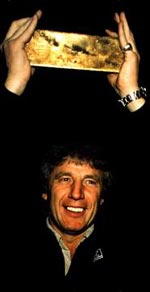 Keith Jessop, the salvage diver who recovered the gold from the HMS Edinburgh, died on May 22, 2010, aged 77.
Keith Jessop, the salvage diver who recovered the gold from the HMS Edinburgh, died on May 22, 2010, aged 77.
On May 2, 1942, after three days of attacks by German submarines, destroyers and aircraft in the Barents Sea, the mortally wounded cruiser HMS Edinburgh was given her coup de grâce by a torpedo fired from one of her escorting destroyers, and slid from sight beneath the waves. About 840 of her crew of nearly 900 who had not been killed in the attacks on her had been safely transferred to other British warships of the convoy escort.
The sailors had been saved, but a cargo of bullion, 4½ long tons (4,572kg) of gold bars, carried in the cruiser’s bomb room, went to the bottom with her. The 465 gold ingots were part of Stalin’s payment to Britain for the supplies and military aid that the Allies were shipping to the Soviet Union along the perilous Murmansk convoy route. In the years following the end of the war they were to become the focus of an intensive effort to recover them by successive British governments.
Finally, in the early 1980s, after several abortive efforts to retrieve the gold, the self-made diver Keith Jessop achieved the remarkable feat that had eluded a number of long-established, well-financed salvage companies. It was the culmination of a government effort that had been a stop-start affair since 1954 when a contract had been awarded to the UK-based company Risdon Beazley, but work had been aborted by strained relations between the British and Soviet governments. The designation of the Edinburgh site as a war grave in 1957 only complicated matters, putting a further stop to intrusive exploration of the wreck.
But in the late 1970s, with a Labour Government increasingly anxious to recover the gold to swell the Exchequer’s coffers, efforts were renewed, and a number of companies made bids for the contract. In 1981 Jessop Marine, which under its founder had developed complex cutting machinery and the saturation diving techniques that enabled divers to avoid the deadly effects of the “bends”, permitting them to work at depth for long periods, won the argument about sensitivity to a war grave site against other companies which favoured explosives-led methods of entering the wreck.
In April 1981 Jessop’s survey ship Dammtor had located the cruiser’s final resting place at a depth of 800ft (245m) in a position approximately 72.35N, 35.00E. Its detailed filming of the wreck enabled Jessop to plan his operation with military precision. By August 30 that year the dive-support vessel Stephaniturm was at the wreck site and salvage operations began in earnest. In spite of injury to several of the Jessop marine divers, on September 15 one of them penetrated the armoured room and recovered the first bar of gold. Over the next three weeks, until bad weather forced the suspension of diving on October 7, 431 of the 465 ingots were been recovered, worth an estimated £45 million.
Read the rest of the obituary.
Thanks to Alaric Bond for passing the obituary along.

Love Ya – You Old Fart and I’ll be joining you soon at Sinatra’s for a breakfast ..
Yes Debbie, for Viagra to work there has to be somebody of the opposite sex in the room with you (at least in Keith’s and ny Cases ) You guys explained that to me !!!
To One Of A Kind from One Of The Same Kind : We march to the Drummer of our choosing ..
Go with God ..
Popopete (pke)